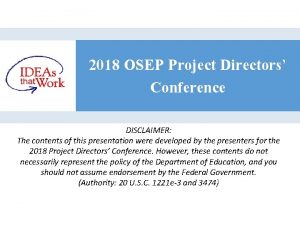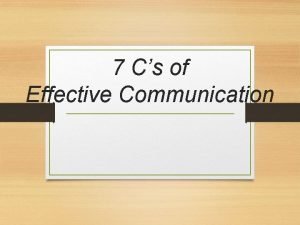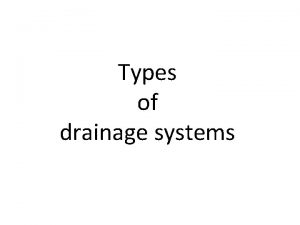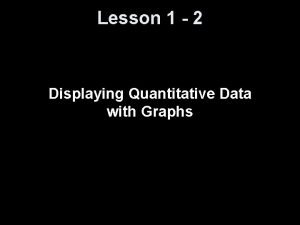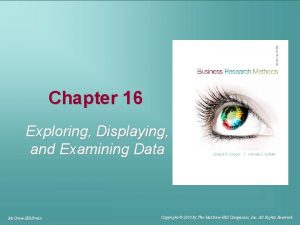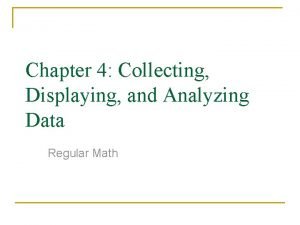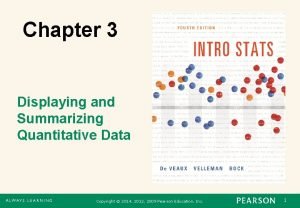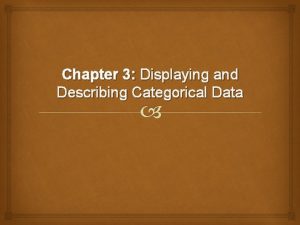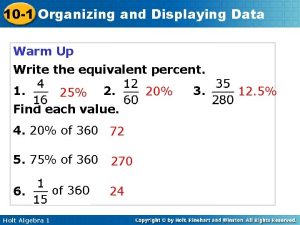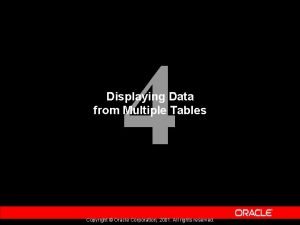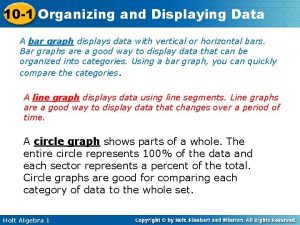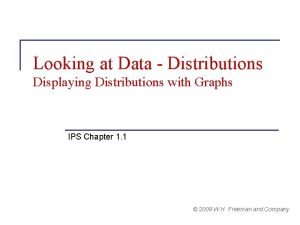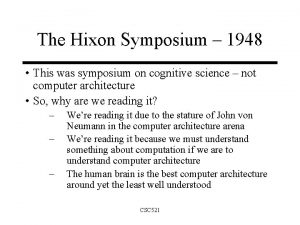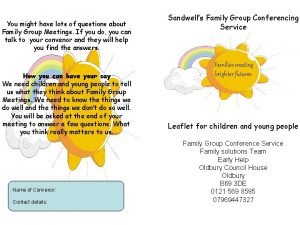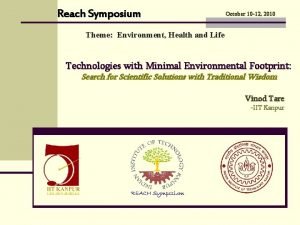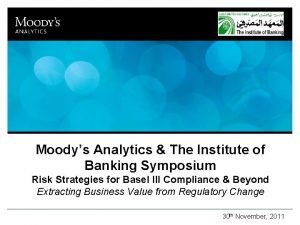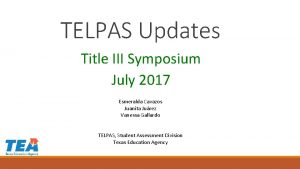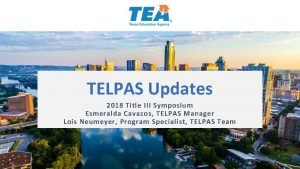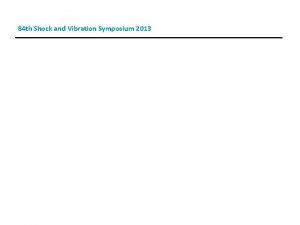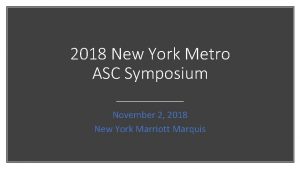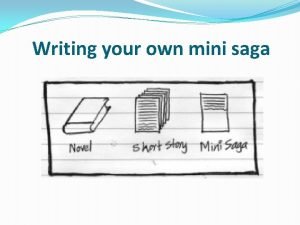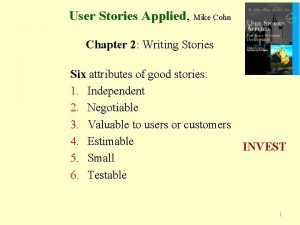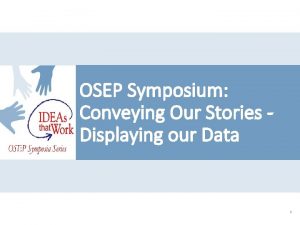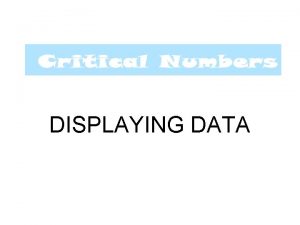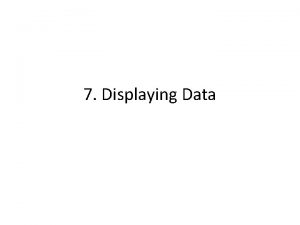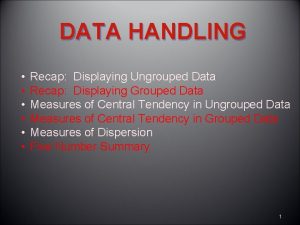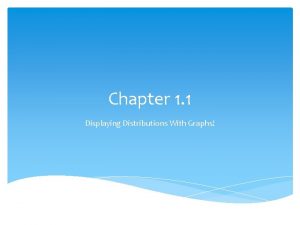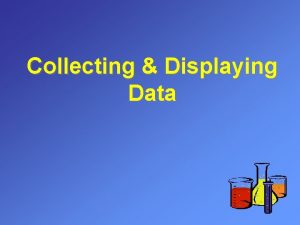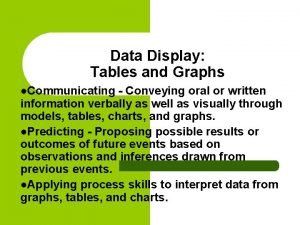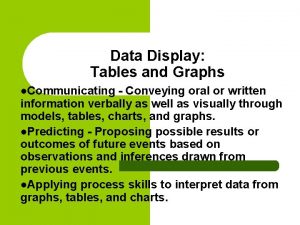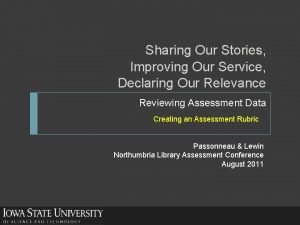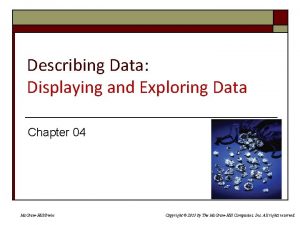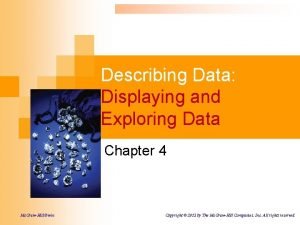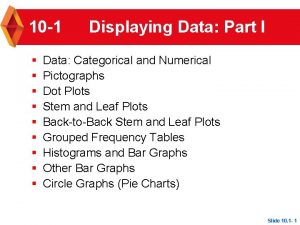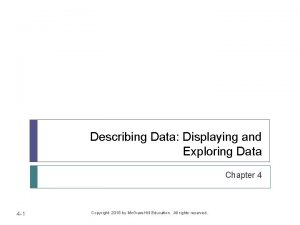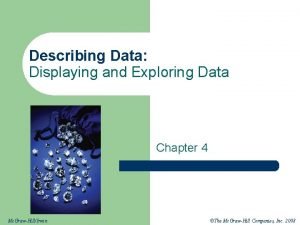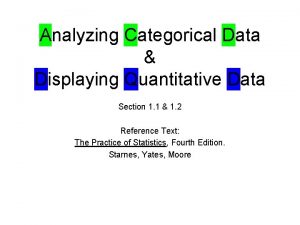OSEP Symposium Conveying Our Stories Displaying our Data














































































- Slides: 78

OSEP Symposium: Conveying Our Stories Displaying our Data 1

Planning for Effective Communication and Engagement 2

https: //www. youtube. com/watch? v=Dzjgm 7 RIZIY&t=5 s&list=PLOEcbg. BUb d. Mf. Zd. Xo. E 0 Y 3 po 6 Ql. DQ 5 XZv. T 7&index=5 3

Effectively Communicating the Results of Your Project – A New Resource Jill Lammert, Westat October 10, 2017 The Center to Improve Project Performance was funded with Federal funds from the U. S. Department of Education, Office of Special Education Programs, under contract number ED-OSE-13 -C-0049. The project officer was Dr. Patricia Gonzalez. The content of this presentation does not necessarily reflect the views or policies of the U. S. Department of Education nor does mention of trade names, commercial products, or organizations imply endorsement by the U. S. government.

Product Overview 1. Understanding evaluation data and their function in communicating project success 2. Developing an effective communication plan 3. Communicating about evaluation data with current project managers and staff 4. Communicating with project funders and benefactors 5. Communicating with current and potential project participants and potential replicators 6. Communication challenges, ethics, and tools 5

Understanding Evaluation Data and Their Function in Communicating Project Success § Communicating about evaluation findings can… – – Ensure high-quality services are provided Promote demand for project services Ensure accountability for current project investments Share important information with project stakeholders and the field § A comprehensive evaluation is an integral part of an effective communication strategy Comprehensive evaluation that answers questions for key stakeholders 6 High quality evaluation data Effective communication strategies Effective communication

Linking Evaluation Data to Communication Strategies § What information from the evaluation do you want to share with your audiences and how will you communicate it? § Will the evaluation data you are collecting answer the questions that your audiences will have? § What are the pros and cons of providing (or not providing) a specific piece of information to an audience? Communication Plan 7 Evaluation Plan

Table 1: Strategy Sheet for Developing a Communication Plan Focused On Communicating Specific Evaluation Information 8

Developing an Effective Communication Plan § Who are the project’s audiences, and what are their needs for project evaluation data? – Audiences directly connected to the project • Project managers and staff • Funders and benefactors • Participants, potential participants, and potential replicators – Audiences indirectly connected to the project • Public and the media • Professional colleagues • Policymakers 9

Three Important Questions to Answer for Each Audience § What does the audience need to know? § How will the audience use the information? § What is the best way to communicate information? – Factors that you may want to consider include: • What types of data are most convincing to each audience? • How much data are needed for each audience? • When is the best timing for project communications? • What specific communication tool is best? • What are the cost considerations? 10

Table 3: Strategy Sheet for Tailoring Communications to Target Audiences 11

Communicating About Evaluation Data with Current Project Managers and Staff § What project elements are working well? § What project elements need attention and support? § What project elements can or should continue? § What project elements can or should be modified, scaled back, or eliminated? 12

Figure 2: Example of Using Evaluation Data to Inform Internal Communications WHAT DO THE DATA SHOW? 13 MESSAGE TO STAFF BASED ON DATA

How Context Affects Communications with Current Project Managers and Staff § Internal and external expectations regarding project services and outcomes § Adequacy of financial support for project implementation § Social support for project services 14

Communicating with Project Funders and Benefactors § What does the project do? § Who does the project serve? § Is the project successful (or can/will it be)? § What does the project cost? § What are the opportunities to enhance or expand the project’s success? 15

Table 5: Questions that Funders and Benefactors Often Want or Need to Have Answered 16

Important Considerations When Communicating with Funders § Establish a plan for regular communications early to create a constructive working relationship § Don’t wait to communicate with funders when there are data that suggest the project has encountered challenges § There may be constraints or limitations on activities that might be considered advocacy or lobbying § Funders typically invest in projects to help them accomplish specific goals § Context is important 17

Communicating with Current and Potential Project Participants § Communicate with project participants to… – Convey how important they are to the project – Ensure they have the data they need to effectively participate – Empower participants to become advocates • They can: recruit more participants, advocate for community support, solicit additional resources § When communicating with project participants… – Use the participant’s primary language, provide oral and written communication, consider social media § Consider context, including… – Ease of access to participation and availability of similar services – Project’s social desirability – Returns on investment for participants 18

Table 7: Contextual Information to Inform Communications with Current and Potential Participants 19

Communicating with Potential Replicators § What is the best information to communicate to potential replicators? – Knowing how and when to start – Lessons learned and strategies to improve implementation – General and specific project barriers and supports – Estimated costs – Important contextual factors and evaluation data that may help to inform decisions around these factors 20

Communication Challenges, Ethics, and Tools § Challenges to clearly and effectively communicating evaluation data – Project and evaluation limitations – Contradictory findings – “Negative” findings or implementation problems § Ethical considerations to keep in mind – Evaluators cannot promise to deliver positive findings 21

Table 9: Common Tools for Communicating Evaluation Findings 22

Closing Thoughts § It is important to develop your communication plan in advance, ideally alongside your evaluation plan § Different audiences have different needs for evaluation findings; target communication strategies and tools accordingly § Communicating evaluation findings purposefully and effectively can benefit the project and the field 23

Contact Us! CIPP@Westat. com 1 -888 -843 -4101 24

Transforming Information Effectively Clement Coulston Manager, Communications & Public Relations National Association of School Psychologists clement@clementcoulston. com @clementc 26

Communication Curate Awareness Enrich Perspectives Create Connections Open Opportunities

We have the stories. How can we… Aggregate them to communicate a comprehensive picture? Leverage them to communicate systemic impact?

Visuals to Bring Life to Content Meet people ‘where they are’ on the issue. Bring people together to build support for addressing the issue.

Ideating, Crafting, and Disseminating Infographics


Step 1: Aggregate the Data

Step 2: Identify the Expected Outcomes What is the purpose of the infographic?

Step 3: Develop a Structure & Explore the Data An Introduction Statement (The Why) Highlights, & Priorities (The What) Implications, & Actions (The Now)

Step 4: Connect Content to Visuals Content: Assign team members different tasks to accomplish the goal. Content: Update the documents to reflect the new timeline. Search Terms: People, & name badge Search Terms: Refresh, new, & recycle

Step 5: Disseminate & Enhance Determine how to best disseminate the infographic and what to include with it. As stakeholders engage with the material, be mindful to what resonates & surprises.

Three Lessons to Meaningfully Engage Stakeholders 36

https: //www. youtube. com/watch? v=6 v. J 3 u. Mx. Euy. I&index=6&list=PLOEcbg. BUbd Mf. Zd. Xo. E 0 Y 3 po 6 Ql. DQ 5 XZv. T 7 37

The Center for IDEA Early Childhood Data Systems Making Data Meaningful through Data Visualization October 10, 2017 38

The Challenge 39

The Challenge Presenting data or complex information… in an efficient and meaningful way that is… appropriate for your audience. 40

Making Data Meaningful Audience 41 Purpose Message

Audience • Who are they? What is their role? • What is their most pressing concern that your data can answer? • Why does this issue matter to them? • Do they have a particular point of view? 42

Purpose • Why are you sharing the information? • Why is this information important to the audience? • Why do you want this information to be important to them? 43

Message • What is your point? • What is the audience’s key takeaway, decision-point, or action? 44

Let’s Look at a Child Outcomes Example All states annually report data on the outcomes children 0 -5 achieve in Early Intervention and Early Childhood Special Education. Data are reported on three functional outcomes A. Positive social emotional skills B. Acquisition and use of knowledge and skills C. Taking actions to meet needs Outcomes are measured using two summary statements 1. Percent of children who make greater than expected growth between entry and exit from the program 2. Percent of children who exit functioning at age expectations 45

Child Outcomes Data A. Social Skills B. Acquisition and Use C. Meet Needs Social Skills 1 Social Skills 2 2012 Part C 71. 9 62 79 53. 3 78. 3 60. 5 Part B 619 82. 3 39. 1 81. 3 37. 6 81. 3 53. 6 2013 Part C 73. 13 62. 59 78. 8 53. 79 78. 94 61. 12 Part B 619 82. 34 35. 08 82. 52 34. 24 81. 81 52. 05 2014 Part C 70. 74 58. 75 76. 88 51. 92 77. 14 57. 42 Part B 619 84. 8 36. 71 83. 17 35. 05 84. 07 54. 46 46

Child Outcomes Data A. Social Skills B. Acquisition and Use C. Meet Needs Social Skills 1 Social Skills 2 2012 Part C 71. 9 62 79 53. 3 78. 3 60. 5 Part B 619 82. 3 39. 1 81. 3 37. 6 81. 3 53. 6 2013 Part C 73. 13 62. 59 78. 8 53. 79 78. 94 61. 12 Part B 619 82. 34 35. 08 82. 52 34. 24 81. 81 52. 05 2014 Part C 70. 74 58. 75 76. 88 51. 92 77. 14 57. 42 Part B 619 84. 8 36. 71 83. 17 35. 05 84. 07 54. 46 47

Child Outcomes Data, 2012 -2014 Example of when charting is not an effective tool 90 80 70 60 Percent 50 40 30 20 10 0 48 A - SS 1 - C A - SS 1 - 619 A - SS 2 - C A - SS 2 - 619 B - SS 1 - C B - SS 1 - 619 B - SS 2 - C 2012 B - SS 2 - 619 C - SS 1 - C C - SS 1 - 619 2013 C - SS 2 - C C - SS 2 - 619 2014

Part C Positive Social Emotional Outcomes, SS 1 & SS 2 Summary Statement 1 The percent of children who substantially increased their rate of growth decreased by two percentage points 73% 72% 71% 2012 49 2013 2014 Summary Statement 2 The percent of children who are functioning within age expectation decreased by 4 percentage points. 62% 63% 2012 2013 59% 2014

An Example of A Simple, yet Effective Presentation of Data 50

An Example of a Chart Made Using Tableau https: //public. tableau. com/profile/kerry. belodoff#!/vizhome/Test 2_448/Dashboard 2 51

Da. Sy-NCSI Data Visualization Toolkit http: //dasycenter. org/data-visualization-toolkit/ 52

The contents of this presentation were developed under a grant from the U. S. Department of Education, # H 373 Z 120002. However, those contents do not necessarily represent the policy of the U. S. Department of Education, and you should not assume endorsement by the Federal Government. Project Officers, Meredith Miceli and Richelle Davis. 53

Communicating with Legislators 54

Jane West Ph. D. Education Policy Consultant janewestdc@gmail. com @janewestdc October 10, 2017 55

56

Your Goals in Meeting with Legislators • Build a relationship so you become a “go to” resource; this is your “first date” of what you hope will be long term • Demonstrate how what the legislator (or the body she serves in) is doing makes a difference (or could make a difference) to her constituents • Provide answers to questions 57

What do Legislators Want to Know? • Did I (or the body I serve in) have any role in supporting funds or policy for your work? • What problem of public significance (that is or should be on my radar screen) are you addressing? • What is the impact/outcome of your project/grant? • What would the impact be if your project/grant was eliminated? What would the unmet need be? 58

Know Who You are Meeting With • What is their track record on your issue/related issues? • What role do they play in the body where they serve (e. g. Chair of Education Committee? ) What authority do they have? • What are their priorities related to your priority in meeting with them? Intersection? • Check their website/twitter/facebook 59

REMEMBER • You, as a constituent and citizen, are the EMPLOYER of the elected representative – local, state, federal level • By voting “you hire them and you fire them” • However – you are there on behalf of your project so stick to that • Every legislator wants to be informed about what is going on with their constituents • You do not have to agree with them. You can disagree without being disagreeable! 60

Your Role • A constituent • An expert • A knowledgeable resource with information/expertise and access to important networks • An educator – educate them! • An advocate for students with disabilities and those who serve and support them 61

Developing “Leave Behinds” • One to two pages! No more • Infographs are great! • Get to the POINT! • Nothing (or VERY LITTLE) on methodology • Highlight IMPACT • Include your contact information 62

HECSE Template

64

65

A Good Meeting • Short • Purpose “I am here to share with you the critical impact that funding to support employment for high school students with disabilities has made in your district. ” • Combine data and a powerful story • Ask them about their priorities and how you might support them • Be ready to answer “What can I do for you? ” THE ASK 66

Follow Up • Always get emails, contact info for staffers, and leave your card • Follow up with thank yous • Provide any information (IN SHORT FORM) they were interested in or requested • Every couple of months check in with a short email with good news • Invite them to teach your class or visit your program • Attend town halls • Go back at least every year 67

Advocates not Lobbyists • An advocate informs, educates, provides information and resources • A lobbyist often is paid to ask for funding or legislation etc. • Check with others to confirm your activities to ensure you are inside the guidelines; every state has different rules; public vs. private etc. • Federal funds cannot be used to support lobbying 68

TWITTER • Most legislators have twitter accounts; do you? • Tweet about your projects regularly! Good practice shortening your message! • Follow your legislators on twitter; tag them when you are reporting results • @janewestdc See you there! 69

That’s All Folks! 70

Social Media: New Low. Cost Tools for Effective Outreach 71

https: //www. youtube. com/watch? v=Y_z 8 AQetv 80&index=7&list=PLOEcbg. BUbd. M f. Zd. Xo. E 0 Y 3 po 6 Ql. DQ 5 XZv. T 7 72

Conveying Our Stories – Displaying Our Data: Reflections 73

Conveying Our Stories - Displaying Our Data Questions, Actions, and Resources Effectively sharing and communicating outcomes to meet the information needs of different audiences is often challenging. These are key questions, actions, and resources shared during today’s presentation. Questions to Ask Actions to Take Resources to Review How are you learning about your audience and why are you sharing this information with them? Develop an effective, comprehensive communication plan. Da. Sy-NCSI Data Visualization Toolkit How are you translating complex information in ways that resonate and activate? Never stop engaging with your stakeholders. Learn from and with them. CIPP TA Product: Effectively Communicating Evaluation Findings What “leave behinds” are you providing and what follow-up will you pursue? Utilize social media outlets to meet stakeholders where they are. “Was this page helpful? ” OSEP IDEAs That Work website

Conveying Our Stories - Displaying Our Data Key Themes Effectively sharing and communicating outcomes to meet the information needs of different audiences is often challenging. Follow these best practices and tips for more impactful and effective communication efforts! Set Priority Maximize and Utilize Talent Know Your Audience Review Lessons Learned Identify the Purpose Continuously Evaluate & Enhance

Conveying Our Stories - Displaying Our Data Quick Notables icating “Commun findings evaluation effectively d n a y ll u f purpose roject and p e h t it f e can ben the field. ” Maps, interactiv e displays, infographics, an imation, charts, and data tables are all strategies to vis ually present data. Develop relationsh ips with key stakeho lders to recognized as the “goto” person/group. Convene stakeholders to continuously check for assumptions, identify what is missed, and opportunities for collaboration. “Before change can happen, people need to understand the key issues, become motivated to take action, and recognize how they can make a difference. "

Conveying Our Stories - Displaying Our Data Reflection 2 tweets per items… “Ah-ha!” Moments Challenges Surprises Connections

Questions & Answers 78
 Osep syllabus
Osep syllabus Osep leak
Osep leak The activity of conveying information
The activity of conveying information Conveying the message in the least possible words
Conveying the message in the least possible words One pipe system and two pipe system
One pipe system and two pipe system Tailmound
Tailmound Data preparing exploring examining and displaying
Data preparing exploring examining and displaying Collecting and displaying data
Collecting and displaying data Chapter 3 exploring quantitative data answers
Chapter 3 exploring quantitative data answers Categorical data displays
Categorical data displays Organizing and displaying data
Organizing and displaying data Displaying quantitative data
Displaying quantitative data Oracle select from multiple tables
Oracle select from multiple tables Organizing and displaying data
Organizing and displaying data What is the importance of displaying petit fours
What is the importance of displaying petit fours Displaying distributions with graphs
Displaying distributions with graphs Scuppernongs to kill a mockingbird
Scuppernongs to kill a mockingbird Pygame text
Pygame text Riviere fabes symposium
Riviere fabes symposium Hixon symposium
Hixon symposium Conclusion of symposium
Conclusion of symposium International police executive symposium
International police executive symposium Texas suicide prevention symposium
Texas suicide prevention symposium Denver metro speech language symposium
Denver metro speech language symposium Equally well symposium
Equally well symposium Shock and vibration symposium
Shock and vibration symposium Question about family symposium
Question about family symposium Malihka burmese restaurant
Malihka burmese restaurant Paano nagsimula ang epiko saang bansa ito nagmula
Paano nagsimula ang epiko saang bansa ito nagmula Lean symposium
Lean symposium Ciarb mediation symposium
Ciarb mediation symposium Florida hazmat symposium
Florida hazmat symposium Acm symposium on cloud computing
Acm symposium on cloud computing Symposium
Symposium Objectives of symposium
Objectives of symposium Banking analytics symposium
Banking analytics symposium Ips perforating
Ips perforating International perforating symposium
International perforating symposium International perforating symposium
International perforating symposium International perforating symposium
International perforating symposium International perforating symposium
International perforating symposium Symposium
Symposium Geo virtual symposium
Geo virtual symposium International perforating symposium
International perforating symposium Eurographics symposium on rendering
Eurographics symposium on rendering Ecfa symposium
Ecfa symposium You couldnt have
You couldnt have Slag valorisation symposium 2021
Slag valorisation symposium 2021 Hemipelvis
Hemipelvis University of southern california undergraduate
University of southern california undergraduate Title iii symposium
Title iii symposium Telpas headphones
Telpas headphones International symposium on molecular spectroscopy
International symposium on molecular spectroscopy Meaning:symposium
Meaning:symposium Symposium betriebswirtschaft westfalen
Symposium betriebswirtschaft westfalen Vsv symposium
Vsv symposium Navmat p-9492
Navmat p-9492 Ny metro asc symposium new york
Ny metro asc symposium new york Ncsu undergraduate research symposium
Ncsu undergraduate research symposium Thinking affects our language, which then affects our:
Thinking affects our language, which then affects our: Our census our future
Our census our future Christ be our light shine in our hearts
Christ be our light shine in our hearts Our life is what our thoughts make it
Our life is what our thoughts make it We bow our hearts
We bow our hearts Our census our future
Our census our future Our life is what our thoughts make it
Our life is what our thoughts make it We quail money makes us quail why?
We quail money makes us quail why? Our awareness of ourselves and our environment
Our awareness of ourselves and our environment Our awareness of ourselves and our environment
Our awareness of ourselves and our environment God our father christ our brother
God our father christ our brother Our future is in our hands quotes
Our future is in our hands quotes Our awareness of ourselves and our environment.
Our awareness of ourselves and our environment. Our awareness of ourselves and our environment
Our awareness of ourselves and our environment Mini saga definition
Mini saga definition User story applied
User story applied Mike cohn user stories
Mike cohn user stories Nytimes
Nytimes Aboriginal dreamtime stories uluru how was it created
Aboriginal dreamtime stories uluru how was it created 8 million stories meaning
8 million stories meaning
